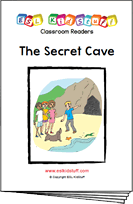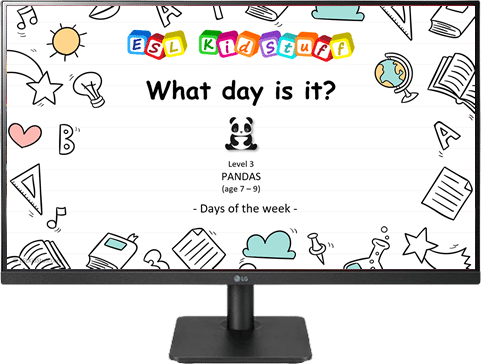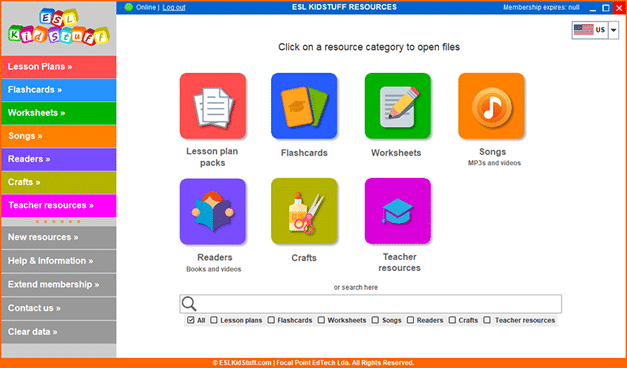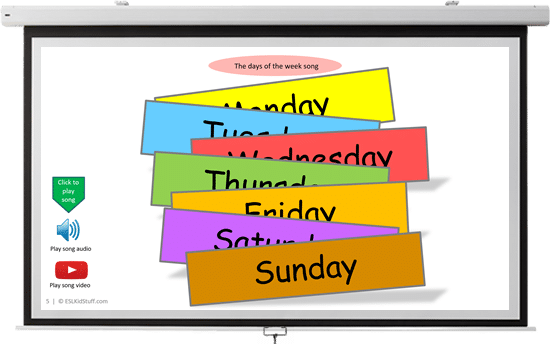Clothes and weather 1 lesson plan
“Put on your shoes”
Lesson 7 Level 3 Age 7-9
Lesson plans for ESL kids teachers
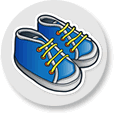
Lesson 7
Clothes and weather 1
This lesson plan introduces the theme of clothes. Students play fun clothing related games and do an active listening activity to a fun song about putting on clothes.
Members get accompanying worksheets, homework sheet, flashcards and song.
Materials:
Our lesson plans are FREE!
Sign up for accompanying:
✔ worksheets
✔ homework sheets
✔ craft sheets
✔ flashcards
✔ PowerPoint lessons & multimedia
✔ song downloads & videos
✔ classroom readers & videos
Click to see lesson details, materials and supplies
Age: 7-9 years
Time: 1 hour – 1 hour 20 mins
Objectives: Identifying different clothing, talking about the weather.
Structures: “Put on your [socks]”, “What is [he/she] wearing?”, “Let’s get dressed”. “How’s the weather?”, “Look outside”.
New vocabulary: shirt, t-shirt, [hide_on_uk]pants[/hide_on_uk][hide_on_us]trousers[/hide_on_us], socks, jacket, shoes, hat, skirt (plus other clothing vocab for other clothes you can bring to class, such as dress, coat, jeans, [hide_on_uk]short pants[/hide_on_uk][hide_on_us]shorts[/hide_on_us], blouse, sweater, [hide_on_uk]necktie[/hide_on_uk][hide_on_us]tie[/hide_on_us], vest, [hide_on_uk]sneakers[/hide_on_uk][hide_on_us]trainers[/hide_on_us], belt).
Review vocabulary: sunny, rainy, windy, cloudy, snowy, foggy, hot, cold.
Lesson materials
Flashcards:
- Weather (sunny, rainy, windy, cloudy, snowy, foggy, hot, cold)
- Clothes (the same cards as the clothing you are bringing to class)
Printables:
- [hide_on_uk]Colorful[/hide_on_uk][hide_on_us]Colourful[/hide_on_us] clothes listening worksheet
- Clothes matchup worksheet
Songs:
- Let’s get dressed
Supplies:
- name tags for each student
- a small ball
- Weather board materials: a piece of cardboard covered with felt, Velcro
- lots of old, adult-sized clothes: at least shirts, t-shirts, [hide_on_uk]pants[/hide_on_uk][hide_on_us]trousers[/hide_on_us], socks, jackets, shoes, hats, skirts. Also, other clothes, though not essential, will be great, such as, dresses, coats, jeans, [hide_on_uk]short pants[/hide_on_uk][hide_on_us]shorts[/hide_on_us], blouses, sweaters, [hide_on_uk]neckties[/hide_on_uk][hide_on_us]ties[/hide_on_us], vests, [hide_on_uk]sneakers[/hide_on_uk][hide_on_us]trainers[/hide_on_us], belts
- board with markers / chalk
In this lesson students start by talking about the day’s weather. Then they’ll play some fun games based around the topic of clothes, including a fast-paced dressing up song activity.
Lesson procedure:
Warm up and maintenance:

1. Greetings and name tags
Greet the students as they enter the classroom and gesture for them to sit down. Before class prepare some blank name tags (stickers or pin-on tags). Give these out and have everyone write their names and put their tags on. If you use pin-on tags, you can keep and give out every class.
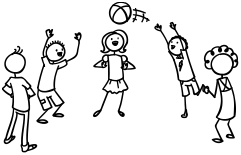
2. Ball pass questions
Get everybody standing in a circle. Throw a ball around, with students asking and answering questions on the below review topics as they throw/catch. Mistakes or wrong answers mean the student has to sit down and is out of that round.
Round 1:
Numbers 1-10 and classroom objects / stationery, e.g. “How many tables are there?”, “There are 6 tables”.
Round 2:
Food and drink words (use a time limit to say a word).
Round 3:
Likes & dislikes for food and drink – “Do you like milk?”, “Yes, I do / No, I don’t”.

3. Homework check
Check each student’s homework that you set in the last lesson. Ask each student some questions about their homework worksheet (e.g. “What weather is this?”, “Do you like rainy weather?”), give lots of praise, and then put some kind of mark on the homework sheet (e.g. a sticker, a stamp or draw a smiley face).
Finally, tell your students to put their homework back into their bags.
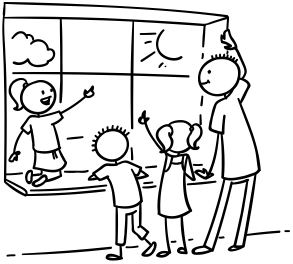
4. Talk about the weather outside
Motion for your students to come over to the window (or even outside). Say a few times, “How’s the weather?”, “Look outside”. Elicit from the class the weather and if it’s hot or cold (you can also teach “warm” if necessary). E.g. “It’s cloudy and rainy and cold”.
Then ask each student in turn, “How’s the weather?” and encourage them to reply. Also ask them if they like that kind of weather (e.g. “Do you like rainy / sunny / hot / cold weather?”).

5. Prepare a “Weather board”
We can use this at the beginning of every lesson to review the weather. Before class, prepare a piece of cardboard and cover it with felt – you are going to pin this to the wall. If you can, try and get blue felt (to represent the sky). Write at the top in large letters, “How’s the weather today?”. Below the write “Today it’s”.
Cut out weather pictures (such as our weather flashcards) and stick some Velcro on the back. Arrange the weather pictures around the edge of the board and then put the board on the wall of your classroom. Invite some students to come up and put weather pictures for today’s weather on the board. As they do this ask, “How’s the weather today?” and elicit, “It’s [word for the picture]”.
New learning and practice:
1. Introduce clothes vocab
Before class you need to collect as many old (adult size) clothes as you can. Have at least the following: shirt, t-shirt, [hide_on_uk]pants[/hide_on_uk][hide_on_us]trousers[/hide_on_us], socks, jacket, shoes, hat, skirt – however, other clothes will be useful as well, such as dress, coat, jeans, [hide_on_uk]short pants[/hide_on_uk][hide_on_us]shorts[/hide_on_us], blouse, sweater, [hide_on_uk]necktie[/hide_on_uk][hide_on_us]tie[/hide_on_us], vest, [hide_on_uk]sneakers[/hide_on_uk][hide_on_us]trainers[/hide_on_us], belt. If you can’t get enough, ask parents to donate some. The clothes need to be adult size as the students are going to put them over their own clothes – big clothes makes the activity fun!
No doubt the large pile of clothes in the classroom will have attracted a great amount of attention, so you’ll have little difficulty in introducing the topic!
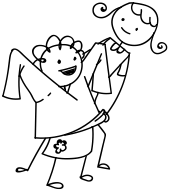
Ask for a volunteer and have him/her stand at the front of the class with you. Tell the class the volunteer is going to get dressed up – with as many different types of clothes as possible! Pull out the first clothing item (e.g. a t-shirt). Elicit / teach and chorus the word x3. Then help your volunteer to put it on. Only put on each item of clothing when you are satisfied that everyone has chorused the word correctly.
Then move onto the next clothing item. As you select each item think about the order – you’ll want your volunteer to be putting the jacket, shoes and hat on last. Keep adding clothes until your volunteer is really well dressed up!
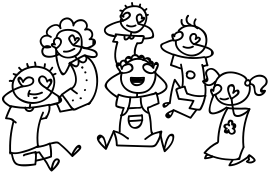
2. Practice the clothing vocab with flashcards
Help the volunteer undress and then get everyone to look at the board. Make sure you have the same clothing flashcards as the old clothes you are using.
Stick the first flashcard on the board and elicit the vocab and write the word clearly below it. Chorus x3. Do the same for all the other flashcards. Next tell everyone to close their eyes and remove one of the flashcards from the board. Now shoutout, “Open your eyes!” – everyone must shout out the missing flashcard. Play this until all the flashcards have been elicited.
3. Play “Clothes team racing”
Divide the class into 2 teams. Line up the 2 teams at one end of the classroom with the old clothes on the floor at the other end. Shout out an instruction (e.g. “Put on some socks!”) and one member from each team will race against the other to the pile of clothes, put on the clothing item and run back to their team. The person who gets back first wins a point for his/her team. At the end, the team with the most points is the winner.
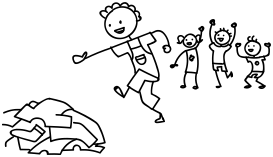
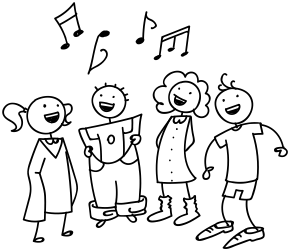
4. Play the “Let’s get dressed” song
This song is an active listening exercise – students listen for the clothing items and then put them on. Make sure the following adult-sized clothes are on the floor: shirt, [hide_on_uk]pants[/hide_on_uk][hide_on_us]trousers[/hide_on_us], socks, jacket, shoes, hat. If you have enough for everyone to get dressed at the same time you can do the song with everyone participating in the activity. If not, have a few students do the song activity while everyone else watches and sings along – you can even give everyone a go by playing the song a few times.
Pile the clothes in a big heap and start the song. As the first clothing item is mentioned (shirt) the students have to scramble in the pile of clothes to find a shirt and put it on before the next item of clothing is mentioned. As the song is played the students put on all the clothes until they are fully dressed. Then finish the game by getting the students to race in taking off their adult-sized clothes – the first to remove them is the winner!
Lyrics for “Let’s get dressed“
It’s time to go to school
Let’s get dressed!
Put on your shirt, put on your shirt,
Quick, get ready, put on your shirt.
Put on your pants, put on your [hide_on_uk]pants[/hide_on_uk][hide_on_us]trousers[/hide_on_us],
Quick, get ready, put on your [hide_on_uk]pants[/hide_on_uk][hide_on_us]trousers[/hide_on_us].
Put on your socks, put on your socks,
Quick, get ready, put on your socks.
Put on your jacket, put on your jacket
Quick, get ready, put on your jacket.
Put on your shoes, put on your shoes,
Quick, get ready, put on your shoes.
Put on your hat, put on your hat,
Quick, get ready, put on your hat.
It’s time to go to school,
It’s time to go to school,
Quick, get ready, let’s get dressed!
Gestures for “Let’s get dressed“
During the song your students will play a wonderful dressing up game – a lot of fun! Before class you need to collect as many old (adult size) clothes as you can for the following vocab: shirt, [hide_on_uk]pants[/hide_on_uk][hide_on_us]trousers[/hide_on_us], socks, jacket, shoes, hat. If you can’t get enough, ask parents to bring in some old clothes for the lesson. The clothes need to be adult size as the students are going to put them over their own clothes – having such big clothes actually makes the activity more fun!
Depending on how many clothes you can find, you can either have everyone dress up at the same time or you can have a few students come up to the front of the class to do the activity. Pile the clothes in a big heap and start the song. As the first clothing item is mentioned (shirt) the students have to scramble in the pile of clothes to find a shirt and put it on before the next item of clothing is mentioned. As the song is played the students put on all the clothes until they are fully dressed. Then finish the game by getting the students to race in taking off their adult-sized clothes – the first to remove them all is the winner!
[hide_on_uk]Short sample (members get full-length song):
[/hide_on_uk]
[hide_on_us]Short sample (members get full-length song):
[/hide_on_us]
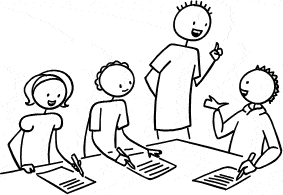
5. Do “[hide_on_uk]Colorful[/hide_on_uk][hide_on_us]Colourful[/hide_on_us] clothes” listening worksheet
Give out a worksheet to each student and tell them to take out their [hide_on_uk]colored[/hide_on_uk][hide_on_us]coloured[/hide_on_us] pencils/pens. Introduce the names of the two characters (Lucy and Tom). Say a clothing item from the worksheet and the [hide_on_uk]color[/hide_on_uk][hide_on_us]colour[/hide_on_us], for example:
“Tom is wearing a blue shirt.”
Students listen to your instructions and [hide_on_uk]color[/hide_on_uk][hide_on_us]colour[/hide_on_us] the clothes items. At the end, get everyone to hold up their worksheets to check.
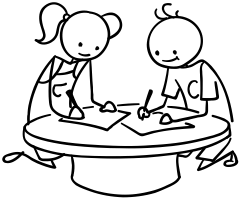
6. Read and write time
This segment can be part of all your lessons. Spend 10 to 15 minutes building up your students’ writing and reading skills. You’ll need to assess your students’ reading/writing level and then choose to start at one of the following stages:
1. Beginners: students cannot read or write the alphabet.
Each lesson introduce 3 lower-case letters of the alphabet (first lesson will be a, b, c). Use flashcards to do this. Play alphabet games and do printing worksheets.
» See our ‘Alphabet a-z (lowercase)’ mini-lesson plans for full details.
2. Early starters: students have experience with the alphabet but need phonics practice.
Each lesson introduce 5 lower-case letters of the alphabet (first lesson will be a, b, c, d, e). Use flashcards to do this. Start by working on the sounds of the letters and then move onto letter clusters (e.g. sh, ee, etc).
» See our ‘Alphabet’ and ‘Letter clusters’ mini-lesson plans for full details.
3. Early readers.
Work on reading and writing simple sentences with lots of practice activities.
» See our ‘Early reading’ mini-lesson plans for full details.
4. Elementary readers: students can read and write simple sentences well.
Work on reading and writing short texts and stories.
» See our ‘Reading short texts’ mini-lessons for full details.
Wrap up:

1. Assign homework: “Clothes matchup“
Hold up the homework worksheet and model matching the words to the pictures and [hide_on_uk]coloring[/hide_on_uk][hide_on_us]colouring[/hide_on_us] them in. Give out the worksheets and say, “Put your homework in your bags”.
2. Do “Quick check” and say goodbye
Time to leave the class. Make sure everything is put away and the students have gathered their belongings. Have them line up at the door and place yourself between the door and the students.

For each student check one new word by holding up the “[hide_on_uk]Colorful[/hide_on_uk][hide_on_us]Colourful[/hide_on_us] clothes” worksheet from today’s lesson and asking, “What’s he/she wearing?”.
When they give you the correct answer say goodbye and let them leave. If their answer is wrong, have them go back to the end of the line – they will have to try again once they reach the front!
Other lesson plans
Levels:
Level 1 lessons (Age 3-5)
Level 2 lessons (Age 5-7)
Level 3 lessons (Age 7-9)
Level 4 lessons (Age 9-12)
Mini lessons (all ages)
Lessons in this level:
- Intro lesson
- In the classroom 1
- In the classroom 2
- Likes and dislikes 1
- Likes and dislikes 2
- Weather
- Clothes and weather 1
- Clothes and weather 2
- Days of the week
- Daily routines & time 1
- Daily routines & time 2
- Daily routines & time 3
- Daily routines & time 4
- Ability and family 1
- Ability and family 2
- Body and family 1
- Body and family 2
- Pets and possessions 1
- Pets and possessions 2
- Months and seasons 1
- Months and seasons 2
- Months and seasons 3
- Describing people 1
- Describing people 2
- Describing things 1
- Describing things 2
Special lessons:
- Christmas lesson
- Halloween lesson
- Easter lesson
- Thanksgiving lesson




